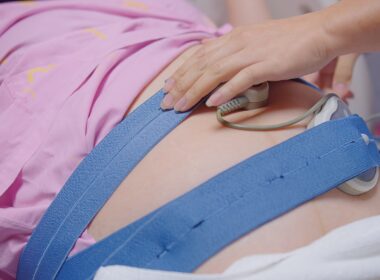Spotting between periods might not seem like too bothersome of a problem to have in and of itself. But a certain kind of spotting could be a sign of a very serious disease: endometriosis.
What happens when you complain about spotting to your doctor? If you are dismissed, you may need to look further. Yes, a lot is written about spotting between periods, and some causes can easily be verified and eliminated, whether it’s your birth control method (the pill or IUDs), a pregnancy, an STI, or another kind of infection. But spotting before your menstrual flow begins could be a sign of an underlying issue or disease, such as uterine fibroids, polyps, or hormonal issues, and even possibly endometriosis.
The challenges of getting to the root cause of spotting are twofold: The first is knowing how to track and document the type of spotting you experience, and the second is finding a doctor who can use this information to help you.
In the following article, we’ll tell you how you can accomplish both.
How spotting is different from a period
It’s important to note that each woman may experience spotting differently, and different kinds of spotting may mean different things. But simply put, spotting is any bleeding that occurs outside of your normal menstrual bleeding (your period). Spotting is usually light, and typically, it will not fill a pad or tampon. You may notice spotting in your underwear, or when you wipe, and it may be a different color (light pink or brown) than your typical period flow (red). Your spotting may be regular (always coming at the same time in your cycle, such as during ovulation), or it may be sporadic.
Premenstrual spotting could be a predictive sign of endometriosis—but it might not be the best one
An estimated 5.5 million American women suffer with endometriosis, a mysterious condition which causes uterine tissue to grow outside of the uterus. No one really knows why this happens. This misplaced tissue responds to hormones the same way as regular uterine tissue, thickening when estrogen is high, sloughing off or bleeding when progesterone levels drop off. Endometriosis tends to get progressively worse, and can lead to fertility issues in addition to severe inflammatory pain from trapped blood, adhesions, and scarring.
If you are someone who regularly experiences spotting before your menstrual flow begins, it may be an indication that you have endometriosis. A small study from 2014 published in the American Journal of Obstetrics and Gynecology (AJOG) shows that premenstrual spotting was the clearest predictor of endometriosis among other possible warning signs [1]. The study defined premenstrual spotting as very light bleeding that lasts for two days or more before the start of your true menstrual flow. Endometriosis was found significantly more often among women who reported premenstrual spotting compared to women without this symptom, according to the study’s lead investigator Dr. Ryan Heitmann, D.O.
However, more recent evidence suggests that symptoms like pelvic pain, dyspareunia (pain during sex), dysmenorrhea (painful periods), irregular cycles, and infertility, may be better indicators of endometriosis than spotting [2]. This is because spotting can also be due to other factors, such as polyps and fibroids, as mentioned above. But if you are experiencing spotting along with any of the other symptoms of endometriosis, charting your cycles with a fertility awareness method (FAM) may help you get to the bottom of it.
Charting is the best way to document and define spotting
Despite the possible link to premenstrual spotting and endometriosis or other gynecological issues, many women and their doctors don’t think twice about it. So how can you know and raise the possibility with your doctor that your pattern of spotting may be pointing to this disease—or something else? That’s where charting your cycle can make all the difference.
By charting, you keep a paper or electronic record of your bleeding and bleeding intensity each day. With all of the implications your bleeding—irregular or not—has for your health, this is not something you want to guess at (and with charting, you don’t have to!). By charting consistently over several months, a telling pattern will emerge of when and how long the spotting goes on. In the case of endometriosis-related spotting, what you’re looking for is consistent premenstrual spotting, for at least two days before your period flow starts.
Finding a doctor who understands your cycle and treats endometriosis
If you have noticed a consistent pattern of spotting, you may want to seek the help of a physician or FertilityCare practitioner trained in NaproTechnology. These doctors are especially trained to interpret the information contained in your charts, and know how to treat endometriosis and other gynecological and fertility disorders using restorative techniques.
If you and your doctor suspect that you have endometriosis, your doctor may want to perform laparoscopic surgery to investigate further. If you are officially diagnosed with endometriosis, you should know that it is a serious disease, but that there are effective ways to treat it. In his book on NaProTechnology, Dr. Thomas Hilgers states that medication can offer temporary relief from endometriosis pain, but that it doesn’t help with the infertility caused by this disease. On the other hand, surgery not only reduces the risk of recurrence by up to 93%, but also improves fertility [3].
Bottom line: No matter the cause, you shouldn’t ignore spotting, and you owe it to yourself to find a doctor who takes your spotting and other menstrual irregularities seriously. Fortunately, charting your cycles and finding a doctor who knows how to use the vital information in your charts are both things you can start doing today.
References:
[1] Heitmann R, Langan K, Huang R, Chow G, Burney R. Premenstrual spotting of ≥2 days is strongly associated with histologically confirmed endometriosis in women with infertility. Am J Obstet Gynecol. 2014;211(4):358.e1-358.e6. doi:10.1016/j.ajog.2014.04.041 [2] National Guideline Alliance (UK). Signs and symptoms of endometriosis (monitoring and referral). NICE Guideline, No. 73. National Institute for Health and Care Excellence (UK). 2017 Sep. [online] Available at: <https://www.ncbi.nlm.nih.gov/books/NBK536044/> [Accessed 5 May 2021]. [3] Hilgers T. The Napro Technology Revolution: Unleashing The Power In A Woman’s Cycle. 1st ed. New York, NY: Beaufort Books; 2010.When this article refers to fertility awareness methods (FAM), or natural family planning (NFP), we are referring to Fertility Awareness-Based Methods, evidence-based methods of cycle charting which can be used as effective forms of natural birth control when learned by a certified instructor.
This article was originally published on March 25, 2017 as written by Emily Kennedy. It has since been updated by Natural Womanhood to offer more resources. Last updated May 5, 2021.
Additional reading:
“What causes endometriosis?” and other questions: A Natural Womanhood Endo FAQ
When it Comes to Irregular Periods, Fertility Charting Works Better Than Birth Control
What to Do When Your Doctor Won’t Listen to You
Endometriosis and Autoimmune Disease: What’s the Connection?
From our friends at FACTS: Charting with Endometriosis: An Interview with Specialist Dr. Yeung







